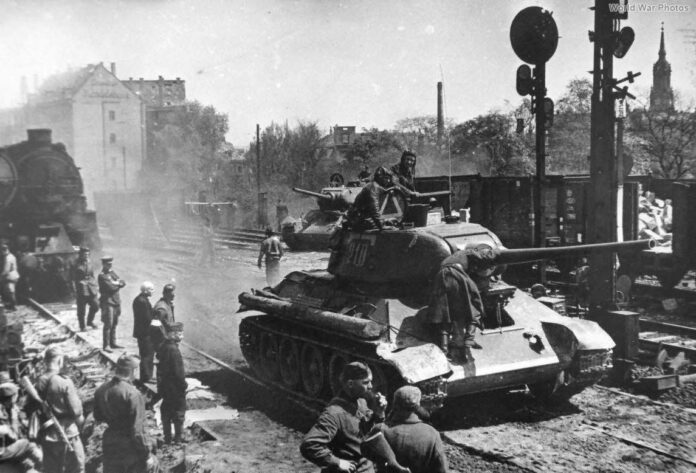It would be inaccurate to label it as the best. It was good. The best? Hardly.
What you cannot deny, is that the T-34 of all variants- and this actually isn’t a jab meant to insult its performance with what I’m about to say -was essentially a tractor with a turret on it.
–
There were elements of the T-34/85 variant’s design that were very appealing and groundbreaking, but if we’re talking about the overall tactical and strategic picture of World War 2, I would argue that the tank wasn’t anything beyond what the Soviets needed it to be.
The 85mm gun on the T-34/85 was capable of knocking out all variants of the Panzer tanks from the latest variant of the Pz IV (the H Ausf) -and below. The 85mm would turn a Panzer IV into chop-meat from almost any distance and from any direction, even on an angle:
–
Meanwhile, the Panzer IV’s long-75mm struggled sometimes to penetrate the T-34’s side-armor at an angle even at close ranges. The T-34/85’s glacis was nearly invulnerable to the long-75mm, as was the glacis on the M4 Sherman:
–
This doesn’t even require a mentioning of any earlier model Panzer tanks such as the III and earlier variants of the IV. The T-34/85 at all times in terms of armor and gun penetration was superior to all versions of the Panzers I, II, III, and IV.
The main contender to the T-34/85 was the Panther, particularly the A and G variants.
While the Panzer IV’s gun struggled against the T-34, the Panther’s long-75mm could penetrate the T-34’s armor from almost any distance and direction:
–
Where the T-34/85 has an advantage over the Panther is in durability and reliance. T-34’s of all variants could quite consistently get the piss kicked out of them and continue working. Water damage, bad terrain, winter conditions, and battle damage are all forms of abuse that T-34’s were quite resistant to.
Panther tanks- by comparison -chewed up their own drive trains, and up until the G variant (particularly with the early D version) -Panthers had a nasty habit of catching their own engines on fire.
German units using Panthers throughout the war rarely were able to deploy more than 55% to 65% of the total number of the tanks allotted to the unit at any one time, where the rest would sit in workshops or behind the lines undergoing maintenance, tunings, and repairs.
Panther tanks were unreliable and heavy enough that even for short distances, at all times during its service, the Germans could not trust the tank to keep itself active under its own power. They were very compelled to ship Panthers as close to the action as physically possible by railcar, which is an issue that the T-34 of all variants did not suffer from in the same way:
In terms of firepower, when the Panther actually chose to function, the victor of an encounter between the Panther and T-34/85 would be determined more by whoever saw who first and was able to fire first and hit the other.
Tiger tanks (both I’s and II’s) definitely had an advantage over the T-34, and even though it’s been proven that the “13/1” K/D ratio of the Tiger tank is fiction:
-I would venture that 90% of the vehicular “Kills” Tigers accrued in their time of service were probably T-34′s or derivative chassis types. This has less to do with proving the Tiger’s “Superiority” over the T-34, and more to do with Soviet tactics, and the fact that most of the time, on average, T-34′s would be the vehicle that Tiger tanks would encounter the most frequently.
This is why despite everything that can be said for the T-34’s superiority over all forms of the Panzer tanks, you can’t really get away with saying it was the best tank of WW2.
T-34′s of all variants literally were knocked out in droves, even the upgunned 85mm variant:
-T-34’s died by the bushel in WW2, and even in Korea, where they couldn’t establish a positive exchange ratio with the just as aged, smaller-gunned M4 Sherman tanks still in service with the US Army in the 50’s.
T-34/85’s were decent enough, i.e: they were numerous, easily replaced, easily serviced, could be driven by an idiot, had the hitting power to knock out Panthers and Tigers, and were excellent infantry support vehicles with decent enough protection to make them somewhat survivable, as long as the enemy wasn’t able to corner them, or detach them from their infantry support.
What you also have to keep in mind is that T-34’s were the closest anyone’s ever come to making a real-life disposable tank.
Thousands of T-34’s were “Lost” -during shipment to the front, and many thousands more showed up with broken parts, internal mechanisms that did not function, missing parts, or eaten drive-trains.
The Soviets realized that it was cheaper and faster to just order 10 new tanks instead of fixing the 10 that showed up broken.
You’ll never get an accurate count of the percentage of T-34’s that essentially got “Misplaced” or were considered “Duds” -at the rallying yard, but you can obviously say it was part of the reason so many of them were built, in addition to loss rates.


